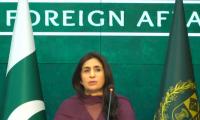KARACHI: State Bank of Pakistan (SBP) on Tuesday left its benchmark policy rate unchanged in a bid to help sustain economic recovery and keep markets stable amid pandemic-related uncertainties.
The Monetary Policy Committee (MPC) maintained the policy rate at 7 percent as widely expected.
The central bank said the latest indicators point to continued improvement in the economic activity and inflation outlook following the recent decline in food prices and core inflation. In addition, consumer and business confidence have risen to multi-year highs and inflation expectations have fallen.
“Against this backdrop, the MPC felt that the uncertainty created by the ongoing fourth Covid wave in Pakistan and the global spread of new variants warrants a continued emphasis on supporting the recovery through accommodative monetary policy,” the SBP said in its monetary policy statement.
The central bank has been holding its rates since June last year, when it had cut them by 100 basis points to 7 percent.
“The SBP has kept the policy rate steady for more than a year as it aimed to support the economy during the coronavirus pandemic,” Governor SBP Dr Reza Baqir said in a news conference held via Zoom after the MPC’s latest meeting.
“The country is facing a fourth wave [of Covid] so we wanted to give the people of Pakistan a feeling of stability as the SBP’s accommodative and supportive monetary policy would be continued,” he said.
“If there is any change needed in the monetary policy stance, it would be gradual and not be similar as it was in 2019 as we had a large current account deficit,” he added.
Baqir said the current account deficit usually goes up in June due to higher payments during this month amid closing of the fiscal year. “This is because of higher global commodity prices, and vaccine imports,” he said.
In an emerging country like Pakistan the current account deficit of a modest 2-3 percent of the GDP was sustainable, the governor said.
He said the SBP’s monetary policy stance and the other measures taken during the Covid yielded positive results. “The SBP wants to pass on the impacts of the economic recovery, decline in inflation, and the increase in the foreign exchange reserves to the masses.
“The SBP, in order to boost the SMEs sector, will introduce a collateral free, cash flow based loans scheme for the small and medium enterprises (SMEs) soon. The government will give guarantee of some part of the principal amount,” Baqir revealed.
A new account opening scheme for domestic Pakistanis would also be launched by which they could open bank accounts without citing bank branches. “The purpose of this scheme is to ease the bank account opening procedure,” he announced.
He said the SBP was likely to launch the digital bank soon to provide easy access to finance to the small level borrowers. The MPC projects economic growth to rise from 3.9 percent in FY2021 to 4-5 percent this year and average inflation to moderate to 7-9 percent this year from its recent higher out-turns.
Imports are expected to grow on the back of the domestic recovery and rebound in global commodity prices, albeit more moderate than in FY2021. The MPC noted that the market-based flexible exchange rate system, resilience in remittances, an improving outlook for exports, and appropriate macroeconomic policy settings should help contain the current account deficit in a sustainable range of 2 - 3 percent of GDP in FY2022.
Notwithstanding this moderate current account deficit, the country’s foreign exchange reserves position is expected to continue to improve this year due to adequate availability of external financing, it said.
In August, Pakistan’s reserve buffers are expected to rise by another $2.8 billion through the IMF’s planned new global SDR allocation.
It repeated the language from May meeting related to future moves being measured and gradual.
“Looking ahead, in the absence of unforeseen circumstances, the MPC expects monetary policy to remain accommodative in the near term, and any adjustments in the policy rate to be measured and gradual to achieve mildly positive real interest rates over time.”
If signs emerge of demand-led pressures on inflation or of vulnerabilities in the current account, the MPC noted that it would be prudent for monetary policy to begin to normalise through a gradual reduction in the degree of accommodation, it said. This would help ensure that inflation does not become entrenched at a high level and financial conditions remain orderly, thereby supporting sustainable growth, it added.
In the event of an unforeseen shock, for instance higher-than-expected oil prices or capital flight from emerging markets due to a tightening of financial conditions in advanced economies, the MPC noted that the market-based flexible exchange rate and improved outlook for domestic investment would help keep the balance of payments position sustainable. In addition, the MPC noted that if balance of payments pressures were to emerge, some normalisation of monetary policy may also be needed, especially if demand-side pressures are at play.
Sheikh argued that the government should have maintained stable petroleum prices
MARI has successfully drilled and tested the third appraisal well in the Ghazij formation in the Mari D&PL
Gold rates decreased by $17 to $2,395 per ounce in the international market
Company's revenue saw a 13.9% year-on-year increase, reaching Rs49.2 billion, up from Rs43.19 billion in the same...
A man counts US dollars in a money exchange shop in Dhaka. — AFP/FileLAHORE: The first thing that the government...
Power generation stood at 8,741 gigawatt-hours or 11,749 megawatts in March







